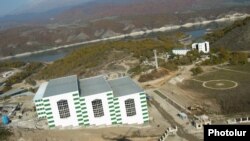Economic growth in Nagorno-Karabakh has averaged about 10 percent annually in the past several years and will continue unabated in 2015, according to the authorities in Stepanakert.
Ara Harutiunian, the Karabakh prime minister, made upbeat macroeconomic forecasts on Thursday as his cabinet pushed through the unrecognized republic’s parliament its budget for next year envisaging a sizable increase in public spending.
The spending target of 88.1 billion drams ($192 million) is based on a projection that the Karabakh economy will expand by 9 percent in 2015.
“A real GDP increase of 9 percent in 2015 and rapid growth in following years are expected to result from the development of energy, agriculture, light industry, food processing, mining, information technology and other sectors,” Harutiunian told lawmakers, according to the Artsakhpress.am news agency.
According to the most recent official data, Karabakh’s GDP, equivalent to over $410 million in 2013, increased in real terms by about 8 percent in January-September 2014 thanks to more than 21 percent rises in industrial output and construction. The two sectors generated between them 58 percent of GDP.
By contrast, the local agricultural sector contracted by as much as 23 percent in the nine-month period apparently because of severe consequences of a blizzard that swept through Armenia and Karabakh in late March. The sector accounted for only one-quarter of economic activity in Karabakh, which used to be heavily dependent on agriculture.
In Harutiunian’s words, recent years’ growth has translated into thousands of new jobs in the Armenian-populated territory still recovering from the 1991-1994 war of secession from Azerbaijan. “The total number of employed workers rose from 41,000 in 2007 to 50,300 in 2014,” he said.
Thousands of other, mostly male Karabakh Armenians are part of the local military closely integrated with Armenia’s armed forces.
Harutiunian emphasized that annual subsidies from the Armenian government will finance 52 percent of Karabakh’s 2015 budgetary spending, down from 60 percent in 2007 and 73 percent in 2000. He said that a large part of the budgetary transfers from Yerevan are taxes collected from goods imported to Karabakh from outside Armenia. This means, he said, that Karabakh is not as financially dependent on Armenia as many people think.
Harutiunian further stressed the fact that state revenue is projected to rise substantially in 2014 despite decreased tax contributions from Karabakh’s largest corporate taxpayer, the Base Metals company mining copper and gold in the northern Martakert district.
Base Metals, which is part of Armenia’s Vallex Group mining giant, is increasingly switching its operations to a new and larger ore deposit in Martakert. Its production volumes should therefore grow in the coming years.
According to official statistics, the average monthly salary in Karabakh rose by 20 percent year on year to 130,400 drams ($300) in September, compared with 173,000 drams in Armenia. The Armenian economy has grown far more slowly since 2010.





